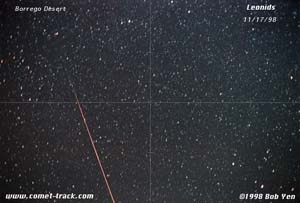
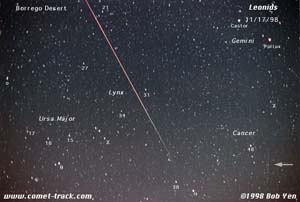
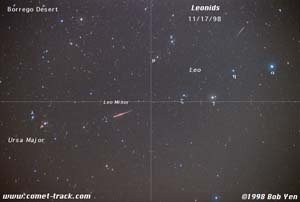
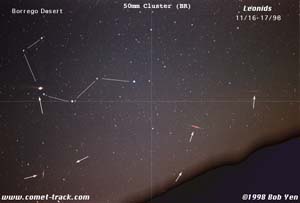




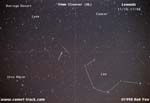
|
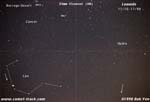
|
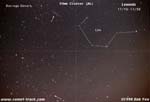
|
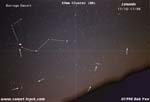
|
BL frame #1 (11:30pm - 11:40pm PST, 11/16)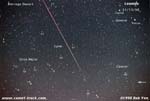 Click for HI-RES image |
NOTE: This is the SAME 50 degree meteor, as recorded with the 16mm fisheye lens. See 16mm section This is the BL (below-left) quadrant of the 50mm camera-cluster, showing the *beginning* of the meteor. (see the *ending* portion in above image) The beginning-portion shows a definite *green* color component (as compared to the predominant red component of the central-portion & end-portion) . The TWO bright stars in upper-right corner are Castor & Pollux (of Gemini). The meteor is travelling through the constellation Lynx, between Gemini & Ursa Major. Also, note the 2nd meteor (see arrow) at bottom-right corner. The 10 minute exposure recorded 2 meteors. |
UL frame #1 (11:30pm - 11:40pm PST, 11/16)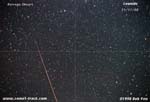 Click for HI-RES image |
NOTE: This is the SAME 50 degree meteor, as recorded with the 16mm fisheye lens. See 16mm section This is the UL (upper-left) quadrant of the 50mm camera-cluster, showing the *ending* of the meteor. (see the *beginning* portion in above image) The central & end portion, is predominantly red-colored. The TWO bright stars in lower-right corner are Castor & Pollux (of Gemini). Compare with above image. |
BL frame #20 (2:50am - 3:00am PST, 11/17)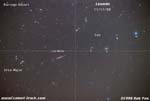 Click for HI-RES image |
This is the BL (below-left) quadrant of the 50mm camera-cluster, showing 2 radiant meteors from Leo's "Sickle". NOTE: the morphology of meteor-trails is clearly observed: the beginning-portion has a *green* component, versus the *red* component of the *thickening* central-portion & *narrowing* end-portion. The *apparent* length of the meteors is not as great, due to their proximity near the radiant (i.e., fore-shortening effect). Visually, these near-radiant meteors had a different "feel": they appeared more "energetic", since the light energy is integrated over a smaller field. NOTE: These are the same meteors, as recorded with the 16mm/frame #24 lens. See 16mm section |
BR frame #9 (12:20am - 12:30am PST, 11/16) Click for HI-RES image |
This is the BR (below-right) quadrant of the 50mm camera-cluster, showing 6 near-radiant meteors (emanating from Leo's "Sickle") over a 10 minute period. There is a (fore-shortened) fireball, near Zeta-Leo. Note the bifurcated debris-trail (the origin-points are located at the *apex* & *terminus* of the main meteor-trail). Note that the origin-points have an aqua-marine color (probably the sublimation of the meteor, caused by implosion due to aerodyanmic braking/heating) NOTE: These are the same meteors, as recorded with the 16mm lens/frame #24 lens (see 16mm section), 20mm lens/frame #13 lens (see 20mm section) (See above for comments on meteor-trail morphology) |
 Click for HI-RES image |
UNDER CONSTRUCTION: come back until Dec 1 for additional images |